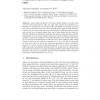226 search results - page 23 / 46 » Mining Prediction Rules from Minority Classes |
CIKM
2006
Springer
13 years 11 months ago
2006
Springer
We present a novel approach for classifying documents that combines different pieces of evidence (e.g., textual features of documents, links, and citations) transparently, through...
FQAS
2006
Springer
13 years 11 months ago
2006
Springer
Action rules introduced in [12] and extended further to e-action rules [21] have been investigated in [22], [13], [20]. They assume that attributes in a database are divided into t...
BMCBI
2010
13 years 7 months ago
2010
Background: Complex human diseases are often caused by multiple mutations, each of which contributes only a minor effect to the disease phenotype. To study the basis for these com...
PKDD
2004
Springer
14 years 29 days ago
2004
Springer
Attribute noise can affect classification learning. Previous work in handling attribute noise has focused on those predictable attributes that can be predicted by the class and o...
CORR
2010
Springer
13 years 7 months ago
2010
Springer
The aim of this study is to show the importance of two classification techniques, viz. decision tree and clustering, in prediction of learning disabilities (LD) of school-age chil...

